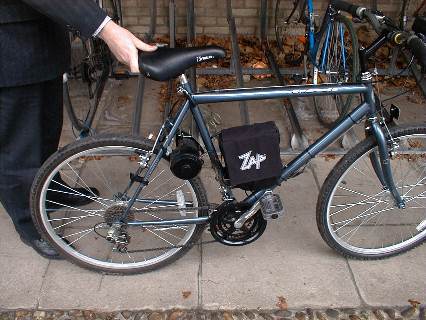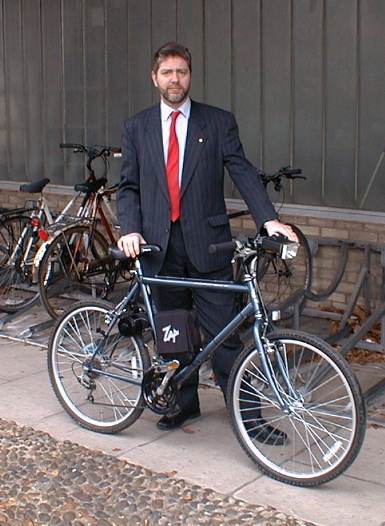 Go to the
Archive index
Go to the
Archive indexI have recently been given the opportunity to test one of the electrically powered bicycles that are currently available. The machine in question is a ZAP, a roller-drive machine from the USA.
I think it would be fair to point out at this stage that electrically-assisted cycling is not for me. This is no criticism of the ZAP - in fact I think the ZAP is one of the better machines in this class - it's just that, if I can't have the power of a petrol engine, I'd rather pedal!
The ZAP is one of the less complicated electric power units that are available. There are four main chunks to the mechanism: the motor, a battery tray, the battery, and a control switch. The electrical connections between these pieces all have in-line plugs, making installation and maintenance easy.
The motor fits above the cycle's rear wheel, between the seat tube and the seat stays. The motor unit is hinged so that its own weight and a spring push its roller down onto the tyre. The roller is forward of the hinge so that there is also a degree of 'self-servo' action helping keep the roller in contact with the tyre.

The battery tray fits within the frame triangle and is securely clamped to the down tube and seat tube; a rear carrier version is available for step-through frames. The battery tray also holds the circuit board and a cut-out. Again, all connections are plugged for ease of maintenance. The battery tray was cracked on the test machine. Not knowing what previous testers had done to the machine, I cannot say why this should be. My testing did not highlight any particular weakness in the tray and the crack did not get any worse while I was using it.
The battery sits in the tray. It is zipped into a fabric container that protects it from the weather and acts as a carrying bag when the battery is off the machine. The bag incorporates a cover that Velcro's onto the tray, and a Velcro strap also makes sure the battery is secure.
The final component is the control switch. This is fitted to the handlebar - left-hand side is recommended - and is a simple on-off switch.
There is one other component: the charger. There are charger sockets on the battery and the bike. Either socket can be used with the battery in situ, or the battery can be removed for charging.
The Zap will fit many bikes, but not all. It clamps around the bridge piece between the seat stays, so the bike has to have conventional stays. One of the clamping bolts passes through the brake/mudguard hole in the bridge piece; this precludes using it with calliper brakes. The frame must also have a big enough gap between the seat tube and seat stays for the motor to fit into. Most modern 'hybrid' bikes with cantilever or 'V' brakes will meet these conditions and, when they tested a ZAP, A2B Magazine managed to fit one to a 20" wheel folding bike for their test, so these restrictions are not all that onerous. In fact, many of these restrictions could be got around with small modifications. It would be a simple task to adapt the mounting to take a calliper brake. It should even be possible to adapt the motor to fit on the front wheel, ahead of the fork crown.

The ZAP is available as a motorising kit to attach to your own bike, or as a complete machine. The ZAP that I tested was delivered as a complete machine. The motor was installed on a 21-speed 'hybrid' style cycle: an Emmelle re-badged as a ZAP Powerbike.
The power unit is simple, robust and easy to maintain: a well thought out design. Its weakest area is probably weather-protection; the ZAP is produced in California, USA where protection from the elements would not be as important as in the UK! The test machine had no mudguards. There would be no problem with fitting a shortened mudguard aft of the motor but some sort of protection in front of the motor is needed too. Lack of mudguards made me reluctant to do any serious wet weather testing, but riding around Suffolk in February meant I still came across my fair share of mud and water on the road. As with any roller drive machine, the roller tends to lift water and mud off the tyre and spray it forwards. This spray covered much of the wiring, including the in-line plug connecting the motor to the battery unit. Some water also found its way between battery and tray, heading towards the electronic circuit board under the battery. Although this did not cause any problems during my test, prolonged exposure to wet weather would not be desirable without some form of mudguard here, perhaps something like a 'Crud Catcher' attached to the bottom half of the seat tube.
While of the subject of mud and water, at no point in my test did I manage to induce any roller slip. This is always a trouble area with roller drive units, but the ZAP's fine toothed steel roller has no problem with gripping the tyre.
Riding the ZAP is simple; hold the switch in and pedal away. The unit does not pull from a stand still but cuts in as soon as the bike starts moving. The engine will power the bike up to the legal maximum (under the UK EAPC regulations) of 15mph. Once moving, there is no need to pedal on the level or up gentle inclines. Steeper hills require pedalling - with a legal limit of 200watts power this is only to be expected. It works best if you don't hurry it. The push from the motor reduces as speed approaches the maximum allowed. If you want to climb hills at 15mph, you'll have to provide most of the effort yourself. However, let the speed drop and the motor will take up more of the work.
The most effective style is one of gentle, unhurried cycling. Fifteen mph is your upper limit, try to go faster and the motor stops helping, in fact it adds a small amount of drag. However, stay within its speed range and you can keep going for miles with the minimum of effort. Of the 21 speeds available from the cycle's derailleur gears, I used about four. In fact, on my first outing, I couldn't get the front changer to work (a fault later traced to the control switch cable fouling the handlebar gear lever - easily cured with a cable tie). I would prefer to have 3-speed or 5-speed hub gears on a bike like this: the proliferation of ratios offered by derailleur systems is not necessary and the ability to change gear quickly when stationary (or nearly so) becomes more important.
My first test ride was about 7 miles and this was completed with no sign at all of the battery flagging. Following this, I used the ZAP for my journey to work: 13 miles. Again, no problems. I put the battery on charge during the morning; some colleagues had a short trial run at lunchtime, and the battery went back on charge during the afternoon. I came home the pretty way, which increased the journey to 15 miles. Just over a mile from home I sensed a reduction in the amount of help I was getting from the motor, dropping almost to nil as I arrived at my front door. I was a little surprised at this: the A2B test that I have already referred to returned consistent journey lengths of over 30 miles to a battery charge. Of course, with a test machine such as this, I cannot be sure how well previous testers have looked after the battery and a later outing achieved a 21-mile round trip on a single charge.
Charging is simple. If you can park the bike near a power point, just plug the charger into the point and plug its lead into the bike. Otherwise, undo the Velcro straps and cover, unplug the battery from the bike, and carry the battery in its bag to the charger. The battery is a sealed lead-acid type - not the cutting edge of battery technology but simple, reliable and effective. The best way to prolong the battery's life is to keep it charged, recharge it after every time you use it. A light on the charger glows red while the battery is charging, when it turns yellow, the battery is ready to use but has not yet reached its maximum charge. The light turns green when it is up to full capacity. At this point the charger output drops so the battery cannot be over charged; it is safe to leave it all plugged in until you next use the bike.
To summarise, the ZAP is a simple but effective electric power unit. It works well within the legal limits laid down by the EAPC regulations. You will find other power units on the market that are more sophisticated, high-tech machines and you can expect to pay two or three times as much for them. There are cheaper motors, but they don't work nearly as well. For value for money, (£350 for the motorising kit) the ZAP is difficult to beat. My only real criticism is its lack of weather-shielding. If you motorise your own bike, this is something that you can easily improvise, but the complete machine really ought to have better protection for the electrics.
ZAP is available in the UK from The EV Network, Sutton House, Auchterarder, Perthshire, PH3 1ED, tel: 01764 664040, fax: 01764 664080, e-mail: info@evn.co.uk
First published - April 1999